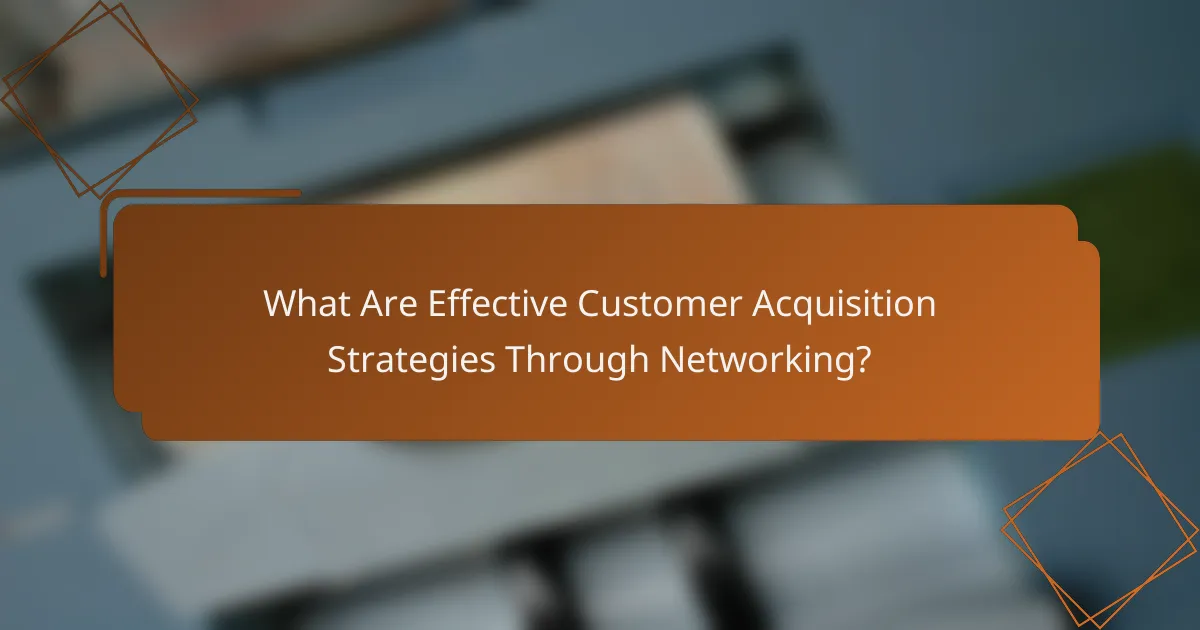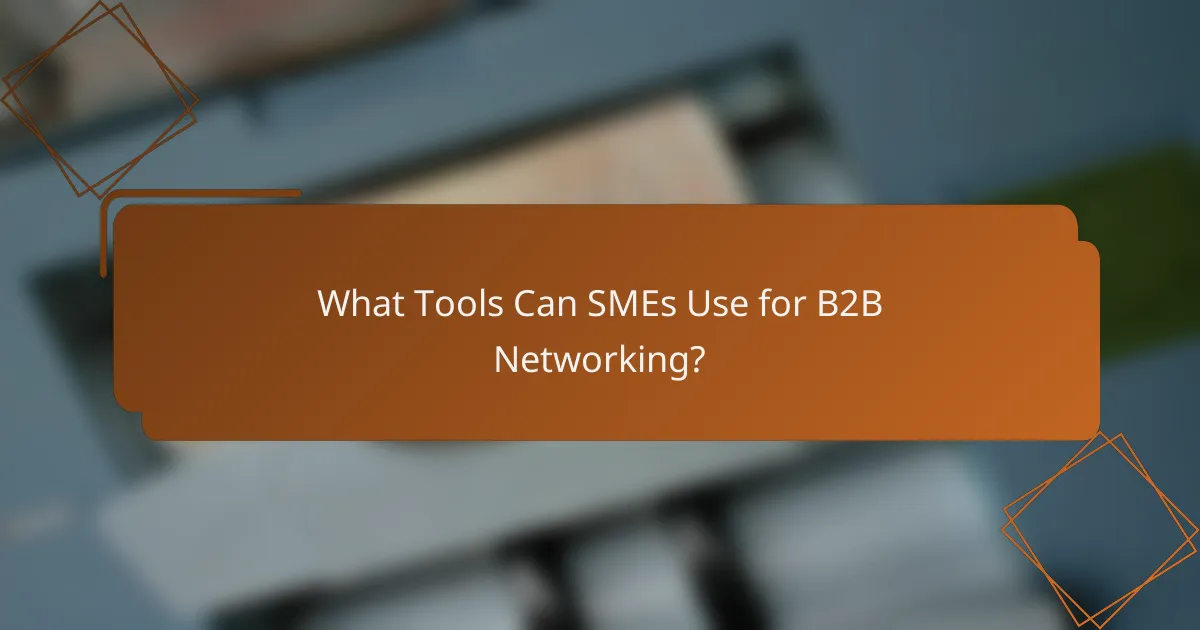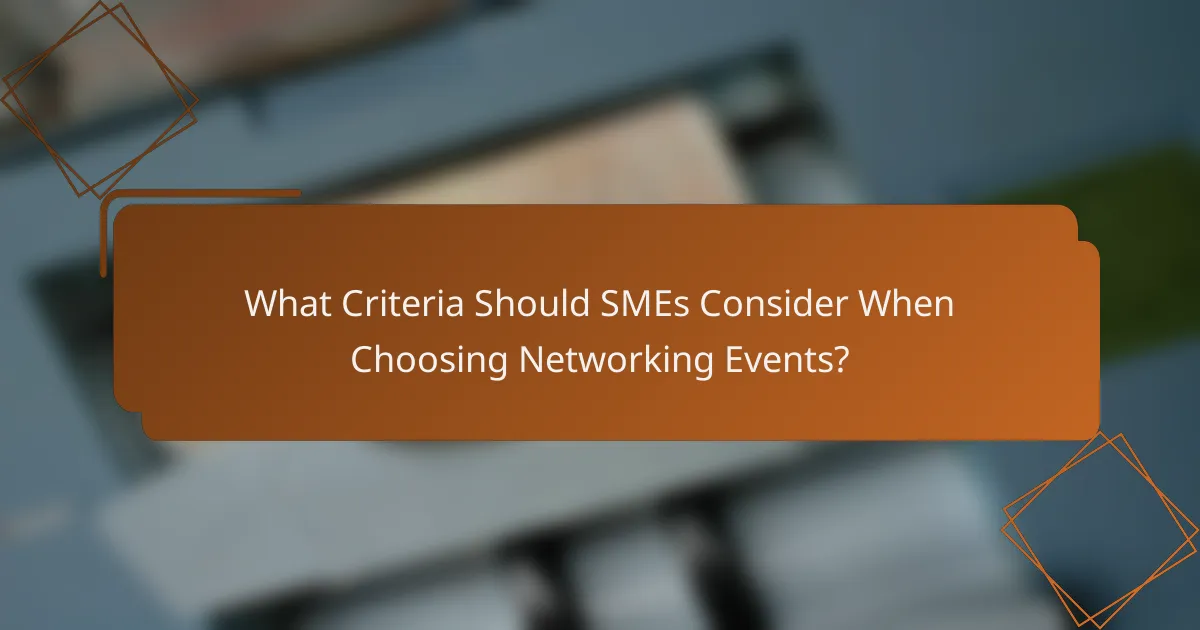B2B networking is a powerful tool for SMEs, driving sales growth by fostering connections that open doors to new business opportunities. By strategically building relationships, these enterprises can enhance customer acquisition and boost brand visibility, ultimately leading to increased revenue and market recognition.

How Can B2B Networking Drive Sales Growth for SMEs?
B2B networking can significantly enhance sales growth for SMEs by creating valuable connections that lead to new business opportunities. Through strategic relationships, SMEs can tap into resources, referrals, and insights that directly contribute to increased revenue.
Increased lead generation
Effective B2B networking expands the pool of potential leads for SMEs. By attending industry events, joining professional associations, and leveraging online platforms, businesses can connect with prospects who are actively seeking their products or services.
Networking can also facilitate partnerships that generate leads through collaborative marketing efforts. For instance, co-hosting webinars or workshops can attract a wider audience and create interest in both businesses.
Enhanced referral opportunities
Networking fosters trust and rapport, which are crucial for obtaining referrals. When SMEs build strong relationships with other businesses, they are more likely to receive recommendations to potential clients.
To maximize referral opportunities, SMEs should actively engage with their network by providing value, such as sharing insights or offering assistance. This reciprocity encourages others to refer their services in return.
Access to new markets
B2B networking opens doors to new markets that SMEs may not have previously considered. By connecting with businesses in different industries or regions, SMEs can gain insights into market demands and customer preferences.
For example, a local manufacturer might network with distributors in other countries, allowing them to explore export opportunities. This can lead to increased sales and a more diverse customer base.
Improved sales strategies
Networking provides SMEs with access to best practices and innovative sales strategies from peers and industry leaders. By sharing experiences, businesses can learn what works and what doesn’t in their respective markets.
Additionally, SMEs can collaborate on sales training initiatives, pooling resources to enhance their teams’ skills. This collective approach can lead to more effective sales techniques and improved overall performance.

What Are Effective Customer Acquisition Strategies Through Networking?
Effective customer acquisition strategies through networking involve building relationships that can lead to new clients and increased sales. By engaging with potential customers and industry peers, small and medium enterprises (SMEs) can enhance their visibility and credibility in the market.
Leveraging industry events
Participating in industry events such as trade shows, conferences, and seminars can significantly boost customer acquisition efforts. These gatherings provide opportunities to meet potential clients face-to-face, showcase products, and gather valuable insights about market trends.
To maximize impact, SMEs should prepare by researching attendees, setting clear objectives, and following up with contacts made during the event. Consider offering exclusive promotions or demonstrations to attract interest.
Utilizing social media platforms
Social media platforms are powerful tools for customer acquisition, allowing SMEs to reach a broader audience at a relatively low cost. By creating engaging content and actively participating in discussions, businesses can build a community around their brand.
Focus on platforms that align with your target audience, such as LinkedIn for B2B connections or Instagram for visual storytelling. Regularly posting updates, sharing industry news, and responding to comments can enhance visibility and foster relationships.
Building strategic partnerships
Forming strategic partnerships with complementary businesses can lead to mutual customer acquisition benefits. By collaborating, SMEs can leverage each other’s customer bases and resources, creating a win-win situation.
Identify potential partners whose offerings align with your own and propose joint marketing initiatives or referral programs. Ensure that the partnership is beneficial for both parties to maintain a strong and lasting relationship.

How Does Networking Enhance Brand Visibility for SMEs?
Networking enhances brand visibility for SMEs by creating connections that increase exposure and credibility. Engaging with other businesses and potential customers fosters relationships that can lead to greater recognition in the marketplace.
Increased online presence
Building an online presence through networking is crucial for SMEs. By participating in industry forums, social media groups, and online communities, businesses can share insights and showcase their expertise, which helps attract attention.
Consider using platforms like LinkedIn to connect with other professionals and share valuable content. Regularly updating your profiles and engaging with followers can significantly improve visibility and establish your brand as a thought leader.
Participation in community events
Participating in local community events is an effective way for SMEs to enhance brand visibility. Events such as trade shows, workshops, and networking meetups allow businesses to interact directly with potential customers and partners.
Consider sponsoring or hosting events to showcase your brand. This not only increases visibility but also builds trust within the community. Aim to participate in at least a few events each quarter to maintain a consistent presence.
Content marketing collaborations
Collaborating on content marketing initiatives can significantly boost brand visibility for SMEs. Partnering with other businesses to create joint blogs, webinars, or podcasts allows for shared audiences and increased reach.
Identify complementary businesses and propose collaboration ideas that benefit both parties. This could include guest blogging or co-hosting events, which can help tap into new customer bases and enhance credibility through association.

What Tools Can SMEs Use for B2B Networking?
SMEs can leverage various tools for effective B2B networking, focusing on platforms that enhance professional connections, facilitate event management, and track customer relationships. These tools are essential for driving sales growth, acquiring new customers, and increasing brand visibility.
LinkedIn for professional connections
LinkedIn is a powerful platform for SMEs to build and maintain professional relationships. By creating a comprehensive profile and actively engaging with industry-related content, businesses can connect with potential clients and partners.
To maximize LinkedIn’s effectiveness, SMEs should regularly share valuable insights, participate in relevant groups, and utilize LinkedIn’s advanced search features to find and connect with key decision-makers. Aim to send personalized connection requests to increase acceptance rates.
Event management platforms
Event management platforms streamline the organization of networking events, webinars, and conferences. Tools like Eventbrite or Meetup allow SMEs to create and promote events, manage registrations, and engage with attendees before and after the event.
When selecting an event management platform, consider features such as ticketing options, attendee tracking, and integration with other marketing tools. Hosting regular events can significantly boost brand visibility and foster valuable connections within the industry.
CRM systems for relationship tracking
Customer Relationship Management (CRM) systems are crucial for tracking interactions and managing relationships with clients and prospects. Tools like HubSpot or Salesforce help SMEs organize contact information, monitor communication history, and analyze customer behavior.
To effectively use a CRM, ensure that all team members are trained on the system and consistently update client information. This practice helps maintain a clear view of customer interactions and can lead to improved sales strategies and customer retention.

What Criteria Should SMEs Consider When Choosing Networking Events?
SMEs should evaluate several key criteria when selecting networking events to maximize their sales growth, customer acquisition, and brand visibility. These criteria include alignment with target audiences, the format and structure of the event, and the associated costs versus potential return on investment.
Target audience alignment
Identifying the target audience is crucial for effective networking. SMEs should consider whether the event attracts potential customers, partners, or industry influencers relevant to their business. For instance, a tech startup might benefit more from a technology-focused conference than a general business expo.
Researching past attendees and the event’s promotional materials can provide insights into the audience demographics. Look for networking events that specifically cater to your industry or niche to ensure a higher likelihood of meaningful connections.
Event format and structure
The format of the networking event can significantly impact its effectiveness. Consider whether the event includes structured networking sessions, workshops, or informal meet-and-greets. Structured formats often facilitate more focused interactions, while informal settings may encourage spontaneous conversations.
Additionally, assess the duration and schedule of the event. Events that allow ample time for networking, such as multi-day conferences, can provide more opportunities to connect with attendees compared to shorter events.
Cost and ROI potential
The cost of attending networking events can vary widely, from free local meetups to expensive conferences. SMEs should evaluate their budget and determine how much they are willing to invest in networking opportunities. Consider not just the ticket price but also travel, accommodation, and any additional expenses.
To assess ROI potential, set clear objectives before attending. For example, aim to generate a specific number of leads or establish a certain number of partnerships. Tracking these outcomes can help measure the effectiveness of the investment in networking events.

How Can SMEs Measure the Success of Their Networking Efforts?
SMEs can measure the success of their networking efforts by evaluating lead conversions and assessing brand awareness metrics. These indicators provide insights into how effectively networking translates into tangible business outcomes.
Tracking lead conversions
Lead conversion tracking involves monitoring the percentage of leads generated from networking that result in actual sales. SMEs should establish a clear process for capturing leads, such as using CRM software to track interactions and outcomes.
To effectively measure conversions, set specific time frames for evaluation, such as quarterly or bi-annually. This allows for the identification of trends and the effectiveness of different networking strategies over time.
Common pitfalls include failing to follow up with leads or not categorizing them properly. Ensure that there is a systematic approach to nurturing leads to maximize conversion rates.
Assessing brand awareness metrics
Brand awareness metrics help SMEs understand how well their networking efforts are increasing visibility in their target market. This can include tracking social media engagement, website traffic, and mentions in industry publications.
Tools like Google Analytics can provide insights into website visits and user behavior, while social media platforms offer analytics on post reach and engagement. Regularly review these metrics to gauge the impact of networking activities on brand visibility.
To enhance brand awareness, consider creating shareable content or hosting events that encourage interaction. Avoid relying solely on one channel; a diversified approach often yields better results in building brand recognition.
